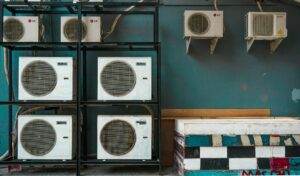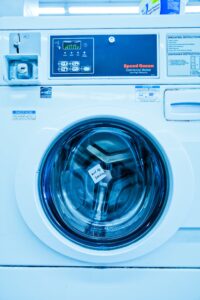The oven door seal may seem like a small and insignificant part of your oven, but it plays a crucial role in ensuring the efficiency and safety of your appliance. The oven door seal is responsible for creating an airtight seal between the oven door and the oven cavity, preventing heat from escaping and maintaining the desired temperature inside the oven. A faulty oven door seal can lead to a variety of issues, including uneven cooking, energy wastage, and even potential safety hazards. In this article, we will explore the importance of an oven door seal, how to identify signs of a faulty seal, common causes of seal failure, troubleshooting and repair techniques, tips for maintaining your seal, and cost-effective solutions for repair.
Understanding the importance of an oven door seal
The oven door seal is designed to create an airtight barrier between the oven cavity and the outside environment. When you turn on your oven, it heats up to the desired temperature and the heat is contained within the oven cavity. The oven door seal ensures that this heat does not escape, allowing your food to cook evenly and efficiently. Without a properly functioning seal, heat can escape from the oven, causing uneven cooking and longer cooking times. This can result in undercooked or overcooked food, which is not only frustrating but also potentially unsafe.
In addition to maintaining the desired temperature inside the oven, a properly functioning oven door seal also helps to conserve energy. When heat escapes from the oven, it not only affects the cooking process but also wastes energy. This can lead to higher energy bills and unnecessary environmental impact. By ensuring that your oven door seal is in good condition, you can maximize the efficiency of your appliance and reduce energy consumption.
Signs of a faulty oven door seal
There are several common signs that indicate a faulty oven door seal. One of the most obvious signs is visible damage to the seal itself. Look for any cracks, tears, or gaps in the seal. If you notice any damage, it is likely that the seal is no longer functioning properly and needs to be repaired or replaced.
Another sign of a faulty oven door seal is if you notice that the oven is not heating up as quickly or maintaining the desired temperature. This can be an indication that heat is escaping from the oven due to a faulty seal. If you find that your food is taking longer to cook than usual or is not cooking evenly, it may be due to a faulty seal.
You may also notice an increase in your energy bills if your oven door seal is not functioning properly. As mentioned earlier, a faulty seal can cause heat to escape from the oven, resulting in longer cooking times and wasted energy. If you see a sudden increase in your energy consumption without any other explanation, it may be worth checking the condition of your oven door seal.
Common causes of a faulty oven door seal
There are several common causes of a faulty oven door seal. One of the most common causes is wear and tear over time. The constant opening and closing of the oven door can put strain on the seal, causing it to deteriorate over time. Exposure to high temperatures can also cause the seal to become brittle and less effective.
Another common cause of a faulty oven door seal is improper cleaning and maintenance. If you use harsh chemicals or abrasive cleaning tools on the seal, it can cause damage and reduce its effectiveness. It is important to clean the seal regularly with mild soap and water and avoid using any harsh chemicals or abrasive materials.
Additionally, accidents or mishandling can also lead to a faulty oven door seal. If the oven door is slammed shut or if heavy objects are placed on top of it, it can cause damage to the seal. It is important to handle the oven door with care and avoid any unnecessary force or pressure.
To prevent these issues from occurring, it is important to practice proper maintenance and care for your oven door seal. Regularly inspect the seal for any signs of damage and clean it properly using mild soap and water. Avoid using harsh chemicals or abrasive materials that can cause damage. Handle the oven door with care and avoid slamming it shut or placing heavy objects on top of it.
Tools and materials needed for troubleshooting and repair
If you suspect that your oven door seal is faulty and needs repair, there are a few tools and materials that you will need. Here is a list of the most common tools and materials needed for troubleshooting and repair:
– Screwdriver: You will need a screwdriver to remove the screws that hold the oven door in place.
– Replacement seal: If your oven door seal is damaged beyond repair, you will need a replacement seal. Make sure to purchase the correct size and type of seal for your specific oven model.
– Mild soap and water: This is used for cleaning the seal and removing any dirt or debris.
– Soft cloth or sponge: Use a soft cloth or sponge to clean the seal without causing any damage.
– Lubricant: If the seal is not sealing properly, you may need to apply a lubricant to help it slide smoothly.
Step-by-step guide to troubleshooting a faulty oven door seal
If you suspect that your oven door seal is faulty, here is a step-by-step guide to troubleshooting the issue:
1. Turn off the oven and unplug it from the power source for safety.
2. Open the oven door and inspect the seal for any visible signs of damage, such as cracks, tears, or gaps.
3. Clean the seal using mild soap and water. Gently scrub away any dirt or debris using a soft cloth or sponge.
4. Check if the seal is properly aligned with the oven cavity. It should be flush against the metal frame of the oven.
5. If the seal is misaligned, try adjusting it by gently pulling or pushing it into place. Be careful not to apply too much force, as this can cause further damage.
6. If the seal is damaged beyond repair or if it is not sealing properly even after cleaning and adjusting, it may need to be replaced.
7. To replace the seal, you will need to remove the oven door. Refer to your oven’s user manual for specific instructions on how to remove the door.
8. Once the door is removed, carefully remove the old seal by pulling it away from the metal frame.
9. Install the new seal by aligning it with the metal frame and pressing it firmly into place.
10. Reattach the oven door and secure it with the screws using a screwdriver.
11. Plug in the oven and turn it on to test if the new seal is working properly.
How to replace a faulty oven door seal
If you have determined that your oven door seal needs to be replaced, here is a step-by-step guide on how to do it:
1. Turn off the oven and unplug it from the power source for safety.
2. Open the oven door and locate the screws that hold the door in place. These are usually located on the sides or top of the door.
3. Use a screwdriver to remove the screws and set them aside in a safe place.
4. Carefully lift the oven door off its hinges and place it on a flat surface, such as a countertop or table.
5. Locate the old seal and carefully peel it away from the metal frame of the oven door. Be careful not to damage the frame or any other components of the door.
6. Clean any residue or adhesive left behind by the old seal using mild soap and water. Gently scrub away any dirt or debris using a soft cloth or sponge.
7. Take the new seal and align it with the metal frame of the oven door. Make sure it is positioned correctly and covers the entire perimeter of the door.
8. Press the new seal firmly into place, making sure it adheres to the metal frame.
9. Once the new seal is installed, carefully lift the oven door and place it back on its hinges.
10. Secure the door in place by reinstalling the screws using a screwdriver.
11. Plug in the oven and turn it on to test if the new seal is working properly.
Tips for maintaining your oven door seal
To ensure that your oven door seal remains in good condition and functions properly, here are some tips for maintenance:
1. Clean the seal regularly using mild soap and water. Avoid using harsh chemicals or abrasive materials that can cause damage.
2. Inspect the seal for any signs of damage, such as cracks, tears, or gaps. If you notice any damage, repair or replace the seal as soon as possible.
3. Avoid slamming the oven door shut or placing heavy objects on top of it, as this can cause damage to the seal.
4. If you notice any issues with the seal, such as it not sealing properly or heat escaping from the oven, address them promptly to prevent further damage.
5. Lubricate the seal if it is not sliding smoothly. Apply a small amount of lubricant to help it move more easily.
6. Avoid using self-cleaning mode on your oven if you have a silicone oven door seal, as high temperatures can cause damage to the seal.
When to seek professional help for oven door seal repair
While troubleshooting and replacing an oven door seal can be done by most homeowners, there are certain situations where it may be best to seek professional help. Here are some instances where you should consider hiring a professional:
1. If you are unsure about how to troubleshoot or replace the oven door seal, it is best to consult a professional. They have the knowledge and experience to handle the repair safely and effectively.
2. If you have tried troubleshooting and replacing the seal yourself but are still experiencing issues, it may be a sign of a more complex problem. A professional can diagnose and repair the issue correctly.
3. If your oven is still under warranty, it is recommended to contact the manufacturer or an authorized service center for repair. Attempting to repair the oven door seal yourself may void the warranty.
4. If you do not have the necessary tools or materials for troubleshooting and repair, it may be more cost-effective to hire a professional who already has the required equipment.
Cost-effective solutions for repairing a faulty oven door seal
If you are on a budget and need to repair a faulty oven door seal, there are several cost-effective solutions available. Here are some tips:
1. If the seal is only slightly damaged or misaligned, you may be able to repair it without replacing the entire seal. Use adhesive or heat-resistant tape to patch up any small cracks or gaps in the seal.
2. Look for generic or universal oven door seals that are compatible with your oven model. These are often more affordable than branded seals.
3. Consider purchasing a DIY oven door seal repair kit. These kits usually include all the necessary tools and materials for repairing a faulty seal at a lower cost than buying individual items.
4. Check if your oven is still under warranty. If it is, contact the manufacturer or an authorized service center for repair. The cost of repairing or replacing the seal may be covered by the warranty.
Preventing future issues with your oven door seal
To prevent future issues with your oven door seal, here are some tips:
1. Practice regular maintenance by cleaning the seal regularly using mild soap and water.
2. Avoid using harsh chemicals or abrasive materials that can cause damage to the seal.
3. Handle the oven door with care and avoid slamming it shut or placing heavy objects on top of it.
4. Inspect the seal regularly for any signs of damage and repair or replace it as soon as possible.
5. Follow the manufacturer’s instructions for cleaning and maintenance to ensure the longevity of your oven door seal.
How Can a Faulty Oven Door Seal Lead to Oven Overheating?
A faulty oven door seal can result in oven overheating. When the seal fails to create a proper closure, hot air escapes, causing heat loss and prolonged heating cycles. This puts strain on the oven, potentially leading to overheating. Diagnosing oven overheating problems requires identifying seal issues and promptly fixing or replacing them.
Final thoughts: The importance of a properly functioning oven door seal
In conclusion, the oven door seal plays a crucial role in ensuring the efficiency and safety of your oven. It creates an airtight seal between the oven door and the oven cavity, preventing heat from escaping and maintaining the desired temperature inside the oven. A faulty oven door seal can lead to uneven cooking, energy wastage, and potential safety hazards. By understanding the importance of an oven door seal, identifying signs of a faulty seal, addressing common causes of seal failure, and practicing proper maintenance and repair techniques, you can ensure that your oven door seal remains in good condition and functions properly.
The oven door seal is a small but important component of your oven that should not be overlooked. It plays a crucial role in maintaining the efficiency and safety of your appliance. By understanding the importance of an oven door seal, identifying signs of a faulty seal, addressing common causes of failure, and practicing proper maintenance and repair techniques, you can ensure that your oven door seal remains in good condition and functions properly. If you suspect that your oven door seal is faulty, it is important to take action promptly to prevent further damage and ensure the optimal performance of your oven.



